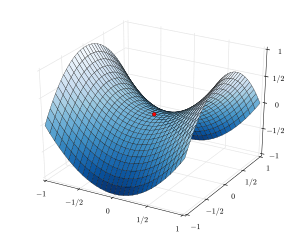| Composition | Roughly, a high-energy composite of 3 leptons or of 3 baryons |
|---|---|
| Status | Hypothetical |
| Mass | ~10 TeV |

A sphaleron (Greek: σφαλερός "slippery") is a static (time-independent) solution to the electroweak field equations of the Standard Model of particle physics, and is involved in certain hypothetical processes that violate baryon and lepton numbers. Such processes cannot be represented by perturbative methods such as Feynman diagrams, and are therefore called non-perturbative. Geometrically, a sphaleron is a saddle point of the electroweak potential (in infinite-dimensional field space).[1][2][3][4]
This saddle point rests at the top of a barrier between two different low-energy equilibria of a given system; the two equilibria are labeled with two different baryon numbers. One of the equilibria might consist of three baryons; the other, alternative, equilibrium for the same system might consist of three antileptons. In order to cross this barrier and change the baryon number, a system must either tunnel through the barrier (in which case the transition is an instanton-like[note 1] process) or must for a reasonable period of time be brought up to a high enough energy that it can classically cross over the barrier (in which case the process is termed a "sphaleron" process and can be modeled with an eponymous sphaleron particle).[6][7]
In both the instanton and sphaleron cases, the process can only convert groups of three baryons into three antileptons (or three antibaryons into three leptons) and vice versa. This violates conservation of baryon number and lepton number, but the difference B − L is conserved. The minimum energy required to trigger the sphaleron process is believed to be around 10 TeV; however, sphalerons cannot be produced in existing LHC collisions, because although the LHC can create collisions of energy 10 TeV and greater, the generated energy cannot be concentrated in a manner that would create sphalerons.[8]
A sphaleron is similar[how?] to the midpoint ( τ = 0 ) of the instanton, so it is non-perturbative. This means that under normal conditions sphalerons are unobservably rare. However, they would have been more common at the higher temperatures of the early universe.
- ^ Phong, Vo Quoc; Khiem, Phan Hong; Loc, Ngo Phuc Duc; Long, Hoang Ngoc (2020). "Sphaleron in the first-order electroweak phase transition with the dimension-six Higgs field operator". Physical Review D. 101 (11): 116010. arXiv:2003.09625. Bibcode:2020PhRvD.101k6010P. doi:10.1103/PhysRevD.101.116010. S2CID 214612257.
- ^ Papaefstathiou, Andreas; Plätzer, Simon; Sakurai, Kazuki (2019). "On the phenomenology of sphaleron-induced processes at the LHC and beyond". Journal of High Energy Physics. 2019 (12): 17. arXiv:1910.04761. Bibcode:2019JHEP...12..017P. doi:10.1007/JHEP12(2019)017. S2CID 204401729.
- ^ Zhou, Ruiyu; Bian, Ligong; Guo, Huai-Ke (2020). "Connecting the electroweak sphaleron with gravitational waves". Physical Review D. 101 (9): 091903. arXiv:1910.00234. Bibcode:2020PhRvD.101i1903Z. doi:10.1103/PhysRevD.101.091903. S2CID 203610139.
- ^ Ho, David L.-J.; Rajantie, Arttu (2020). "Electroweak sphaleron in a strong magnetic field". Physical Review D. 102 (5): 053002. arXiv:2005.03125. Bibcode:2020PhRvD.102e3002H. doi:10.1103/PhysRevD.102.053002. S2CID 218538382.
- ^ Rubakov, Valery A.; Shaposhnikov, Mikhail E. (1996). "Electroweak baryon number nonconservation in the early universe and in high-energy collisions". Physics-Uspekhi. 32 (5): 461–502. arXiv:hep-ph/9603208. doi:10.1070/PU1996v039n05ABEH000145. S2CID 250852429.
- ^ White, Graham Albert (2016). "Section 3.5: The sphaleron". A Pedagogical Introduction to Electroweak Baryogenesis. Morgan & Claypool Publishers. ISBN 9781681744582.
- ^ Klinkhamer, F.R.; Manton, N.S. (1984). "A saddle-point solution in the Weinberg-Salam theory". Physical Review D. 30 (10): 2212–2220. Bibcode:1984PhRvD..30.2212K. doi:10.1103/PhysRevD.30.2212.
- ^ Butterworth, Jon (8 November 2016). "Think of the universe as a skateboard park: Supernovas and sphalerons". Science. The Guardian. UK. Retrieved 1 December 2017.
Cite error: There are <ref group=note> tags on this page, but the references will not show without a {{reflist|group=note}} template (see the help page).